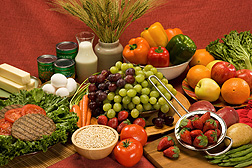| Read the magazine story to find out more. |
|
|
Solid Fats and Added Sugars in Foods
By Rosalie Marion Bliss
November 17, 2015
A surprisingly high proportion of foods consumed in the United States contain some solid fats and added sugars, according to an analysis of U.S. food-consumption data. The study, which was based on an evaluation of food-intake data from a large sampling of the U.S. population, was led by U.S. Department of Agriculture (USDA) Agricultural Research Service (ARS) nutritionist Lisa Jahns.
Solid fats are solid at room temperature, and added sugars are those added to foods—they are nicknamed "SoFAS" by some nutritionists. These SoFAS are also known as "empty calories," according to the 2010 Dietary Guidelines for Americans (DGAs), because they provide few or no nutrients yet are high in calories.
Commercially available food group options may include SoFAS as ingredients aimed to boost flavor and desirability, although much solid fat is naturally occurring, such as in meat and milk. The researchers found that a high percentage of foods recommended for consumption by the Dietary Guidelines for Americans (2010) contained SoFAS particularly in their commercially available forms. Yet a key recommendation of the guidelines is to reduce the intake of calories from SoFAS.
Survey data of 4,046 foods consumed (2007-2008) was used to estimate the proportion of those foods that contained either solid fats or added sugars from within the major food groups (Vegetables, Grains, Proteins, Fruits and Dairy).
Consumer education about hidden fats and sugars in commonly consumed foods can help people make food choices that maximize diet quality while staying within calorie needs, according to the authors.
Jahns is with the ARS Grand Forks Human Nutrition Research Center in Grand Forks, North Dakota.
The study was published in Nutrition Journal.
Read more about this research in the November issue of AgResearch.
ARS is the USDA's principal intramural scientific research agency.

